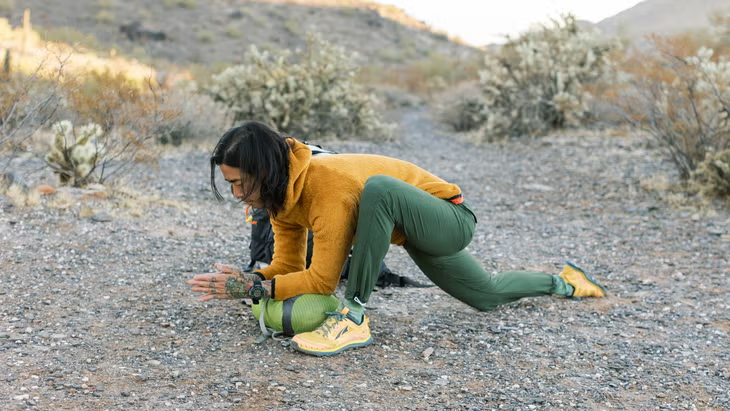
9 Essential Yoga Poses for Backpackers
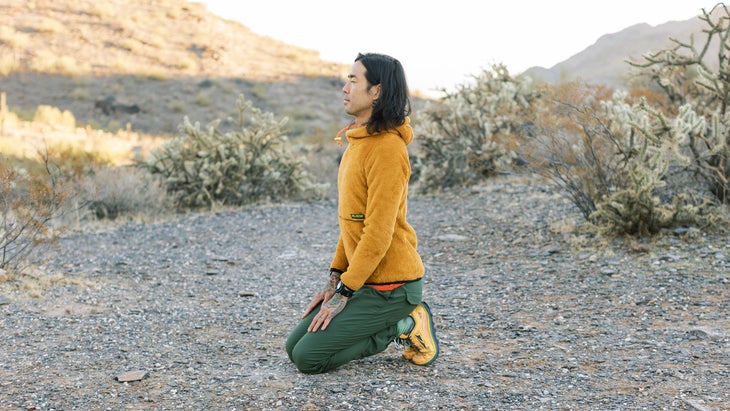
Backpacking can be tough on the body, especially after days of trekking up hills, crossing boulders, or logging long miles on uneven trails. As a long-distance hiker and backcountry ranger, I’ve experienced firsthand the aches and pains that come with hiking. Your knees, lower back, neck, and feet feel the impact, but with the right stretching routine, you can help alleviate these discomforts. Yin yoga, specifically, can provide the deep, sustained stretches needed to release tension and prevent injuries after a long day on the trail.
Here are 9 yoga poses designed for backpackers that will stretch, relax, and recover your body after a tough hike. Plus, they’re easy to do in your tent or any small space with your backpack and sleeping pad!
1. Toe Squat
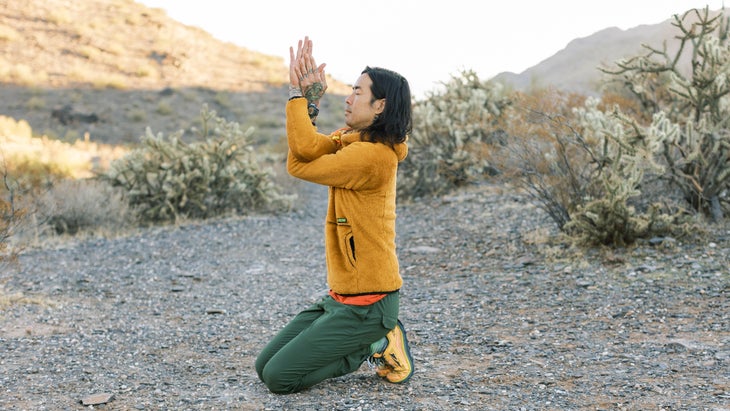
How It Helps:
Long days on the trail can leave your feet sore and tight, especially in the arches. Toe squats help release tension in the plantar fascia, reducing the risk of plantar fasciitis and keeping your feet happy for more miles ahead.
How to Do It:
Kneel down with your toes tucked under you. Keep your spine straight and sit back on your heels, maintaining weight on the balls of your feet. For more intensity, spread your toes wide and hold for 1-3 minutes. If it gets too uncomfortable, shift forward onto your hands for relief.
2. Thread the Needle
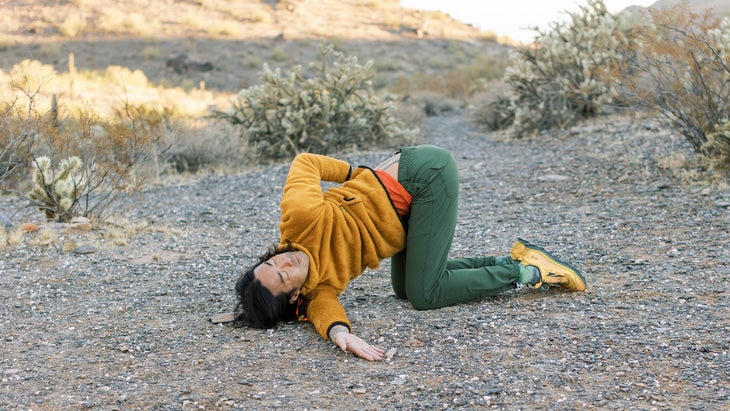
How It Helps:
This twist targets the upper back and shoulders, easing tightness caused by carrying a heavy pack all day.
How to Do It:
Start on your hands and knees. Inhale and lift your right arm towards the sky, opening your chest. On the exhale, thread your right arm underneath your left wrist, resting your shoulder and head on the mat or sleeping pad. Stay for a few breaths, then switch sides.
3. Lizard Pose
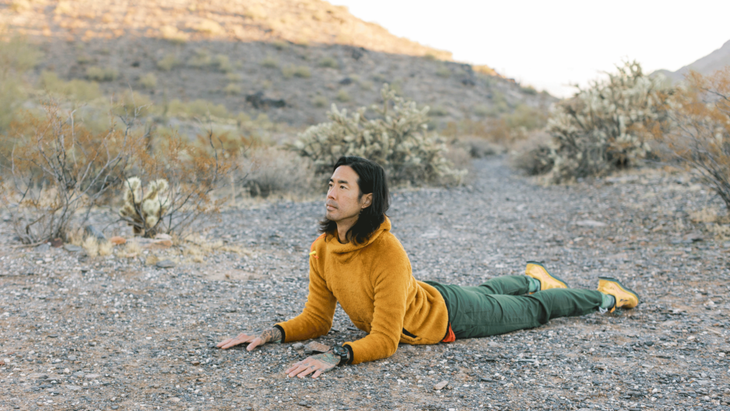
How It Helps:
This deep hip flexor stretch helps release tension in the front body and lower back, especially after hours of walking and hiking.
How to Do It:
From hands and knees, step one foot forward between your hands and lower your forearms to the mat, or place them on your backpack for support. Hold for 3-5 minutes, then switch sides.
4. Sphinx Pose
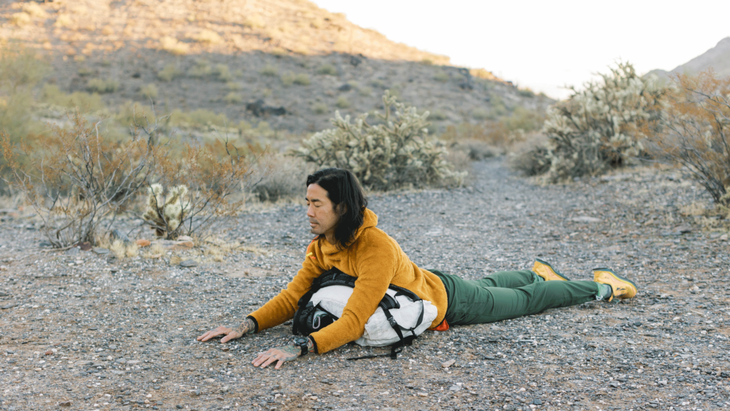
How It Helps:
The Sphinx pose stretches the chest and spine, counteracting the forward hunch from carrying a backpack and sitting.
How to Do It:
Lie on your stomach and prop yourself up on your forearms, keeping your elbows directly under your shoulders. Engage your core and lengthen your spine as you press your chest upward. For additional support, place your backpack beneath your chest. Stay for 1-3 minutes.
5. Restorative Hero’s Pose (Supta Virasana)

How It Helps:
This stretch targets your quads and hip flexors, which are worked hard when hiking uphill or scrambling. It also helps release tension in the lower back.
How to Do It:
Kneel with your knees together and feet slightly wider than your hips. Slowly lower your body between your heels, using a backpack or cushion for support if needed. Hold for at least 2 minutes, focusing on your breath.
6. Supported Forward Bend
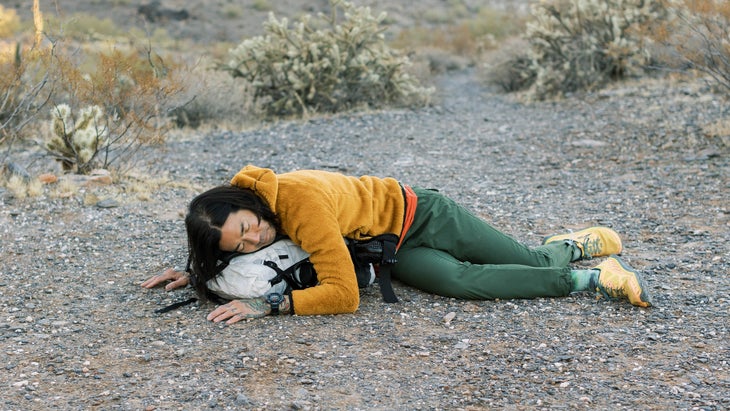
How It Helps:
Hiking shortens the hamstrings. This forward bend stretches the backs of your legs, easing tightness in the hamstrings and inner thighs.
How to Do It:
Sit with your legs spread wide and place your backpack between your legs. Inhale to lengthen your spine, and exhale as you fold forward over the backpack. Hold for 3-5 minutes, adjusting the height with props if necessary.
7. Supported Spinal Twist
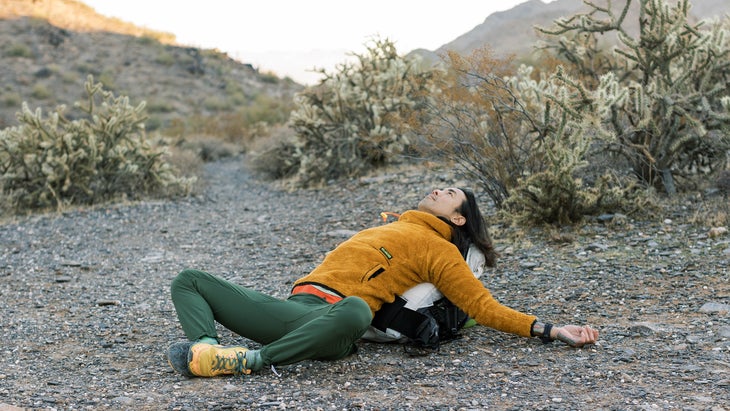
How It Helps:
Twists help release the tension in your thoracic spine, which gets compressed after carrying weight for hours. This pose also aids in digestion and relaxation.
How to Do It:
Sit next to your backpack, turn your upper body toward it, and rest your chest on the pack. Keep your spine long and twist gently, resting your arms at your sides. Hold for 3-5 minutes and then switch sides.
8. Reclined Bound Angle

How It Helps:
This hip opener promotes relaxation, releasing tension in the hip flexors and groin. It’s a great way to unwind after a long day of hiking.
How It Helps:
Sit with your back to your backpack. Bring the soles of your feet together and let your knees fall open. Rest your hands behind you, lean back, and relax your body into the support of the pack. Stay for 3–5 minutes, breathing deeply.
9. Supported Savasana or Legs Up a Tree
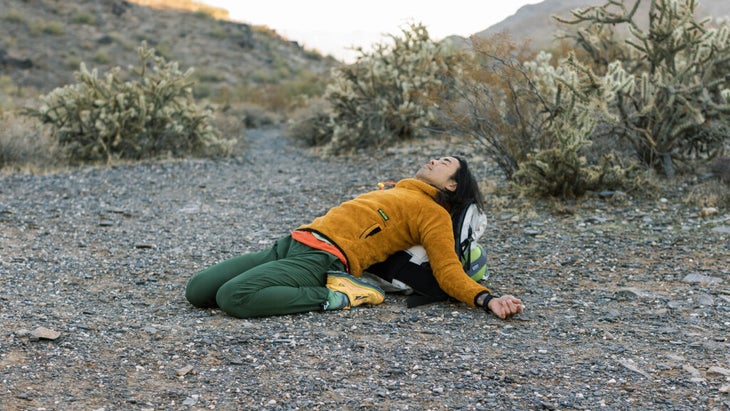
How It Helps:
This is a great way to relieve tension in your lower back after a long day of hiking. Using your backpack as support under your knees helps gently stretch and relax your lumbar spine.
How to Do It:
For Supported Savasana, place your backpack under your knees and rest back into the pose. For Legs Up a Tree, prop your hips with your backpack or a jacket against the tree. Stay in either pose for at least 10 minutes, breathing deeply to let go of the day’s stress.
FAQs About Yoga for Backpackers
1. Can I do these stretches even if I’m not an experienced yogi?
Absolutely! These poses are beginner-friendly and can be modified to fit your body’s needs. The key is to listen to your body and hold each pose for as long as it feels comfortable.
2. Do I need to practice yoga every day while backpacking?
While daily practice would be ideal for maintaining flexibility and reducing muscle tension, even a few minutes of yoga after a long day on the trail can make a big difference in how you feel.
3. How long should I hold each stretch?
Hold each stretch for about 3-5 minutes, especially when practicing yin-style stretches, which work by holding a position for longer periods. If you’re short on time, even 1-2 minutes can provide relief.
4. Can I do these stretches if I don’t have a mat?
Yes! You can practice these poses on your sleeping pad, using your backpack or extra clothing as props. It’s all about making the most of the space and gear you have with you.
5. How can yoga help with backpacking recovery?
Yoga helps by releasing tension, improving flexibility, and lengthening muscles that are contracted from long hours of hiking. It also promotes mindfulness and relaxation, reducing stress and helping your body recover.
Conclusion: Yoga for Backpackers—Recover and Rejuvenate
Backpacking can take a toll on your body, but incorporating yoga stretches into your routine is a great way to recover, release muscle tension, and improve flexibility. With just a few simple poses, you can use your hiking gear to create a makeshift yoga studio, whether you’re at your campsite, in your tent, or even on the trail. Practicing yoga regularly after long hikes will help you stay flexible, reduce discomfort, and make your next adventure feel a little easier on your body.